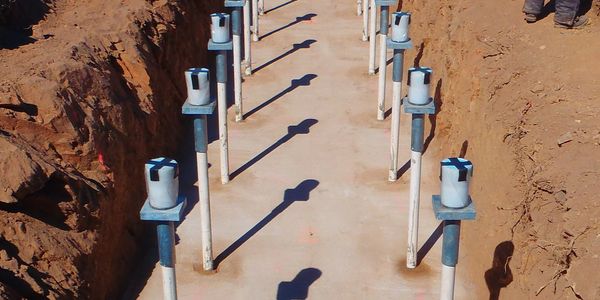Reliable Rock Anchors for Secure and Stable Foundations
In the world of civil design, the role of trustworthy rock supports can not be overstated, as they are critical in establishing safe and secure and steady foundations across a range of applications. Recognizing the various types of rock anchors, their details applications, and the intricacies of installment and maintenance is essential for optimizing their efficiency.
Kinds Of Rock Anchors

Easy supports rely on the weight of the framework and the bordering dirt or rock to give resistance. Active supports, on the various other hand, include the application of tension through a high-strength cable or pole, creating a pre-stressed problem in the support - Williams Anchors.
Grouted supports are an additional substantial category, in which a steel bar or wire is inserted into a drilled opening, adhered to by a cementitious grout. As soon as healed, the cement bonds with the bordering rock, producing a durable anchoring system. Each kind of rock support supplies distinct advantages based on the particular geological conditions and architectural needs, thereby playing an essential duty in the general stability and durability of constructed facilities.
Applications in Construction
Rock supports play a critical role in various building applications, supplying essential assistance and security in varied environments. These ingenious services are utilized in projects varying from massive facilities growths to smaller sized household frameworks. One of the key applications of rock supports remains in the stabilization of slopes and maintaining walls, where they assist protect against soil erosion and keep structural integrity.
Furthermore, rock anchors are instrumental in securing foundations for bridges, passages, and skyscrapers, guaranteeing they can withstand lateral pressures such as wind and seismic task. Their flexibility enables for installment in tough geological problems, making them optimal for tasks in hilly or rough terrains.

Secret Choice Standards
Selecting the suitable rock support for a specific application requires cautious factor to consider of several vital standards. Most importantly, the geological conditions of the site need to be extensively examined. Comprehending rock type, strength, and stability is necessary to make sure that the anchor will certainly carry out successfully under tons conditions.

Another vital aspect is the rust resistance of the support materials. In settings revealed to wetness or chemicals, using corrosion-resistant products will certainly lengthen the life-span of the supports and keep structural integrity with time.
In addition, the anchor's installation approach navigate here ought to align with the project's demands and restraints. Relieve of installment, in addition to the potential effect on surrounding frameworks, need to be considered.
Installation Strategies
Effective installment methods are crucial for the effective efficiency of rock supports. Correct installation makes sure that the supports attain the desired load-bearing capacity and stability within the geological conditions. The initial step in the installation procedure entails website assessment, where geological studies determine the rock type, condition, and any possible obstacles.
Once the website is examined, the proper drilling approach should be selected-- choices consist of rotary exploration, ruby exploration, or percussion drilling. The choice depends on rock hardness and environmental factors to consider. Precise boring depth and angle are vital to make sure that the supports line up with structural requirements and lots circulation.
After drilling, the following stage involves cleaning the borehole to eliminate debris, which can endanger bond stamina. Following this, the anchor is placed, and if called for, a grout or resin is injected to boost bond. The treating time of these materials must be stuck to, ensuring that the anchors accomplish complete toughness prior to any lots is applied.
Upkeep and Evaluation
Appropriate maintenance and inspection of rock supports are vital to guarantee their long-lasting performance and dependability (Williams Anchors). Normal evaluations help determine any possible issues, such as rust, displacement, or structural fatigue that could compromise the integrity of the anchoring system
Regular examinations need to be conducted at defined intervals, thinking about environmental factors and the specific application of the rock supports. Visual evaluations should focus on the exposed areas you could try these out of the supports, looking for indicators of rust, splits, or various other anomalies. Additionally, it is vital to examine the bordering geological conditions to discover any kind of shifts in soil or rock that might impact anchor performance.
In some his comment is here cases, advanced methods such as tons testing or non-destructive testing may be called for to establish the anchors' load-bearing ability and total health and wellness. Correct documentation of evaluation searchings for, maintenance activities, and any type of repairs or substitutes done is vital for recurring analysis and conformity with market criteria.
Conclusion
In conclusion, trusted rock supports play a critical duty in guaranteeing protected and stable foundations throughout different building applications. By properly moving loads and improving security versus side pressures, these anchors add significantly to the durability and honesty of structures such as bridges, passages, and maintaining wall surfaces. Strategic choice, setup, and maintenance of rock anchors are necessary for maximizing performance and guarding public safety, eventually highlighting their relevance in contemporary engineering methods.
Comments on “Discover the Best Williams Anchors for Safeguarding Structures and Keeping Walls”